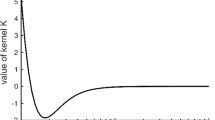Abstract
The ellipsoidal Stokes boundary-value problem is used to compute the geoidal heights. The low degree part of the geoidal heights can be represented more accurately by Global Geopotential Models (GGM). So the disturbing potential is splitted into a low-degree reference potential and a higher-degree potential. To compute the low-degree part, the global geopotential model is used, and for the high-degree part, the solution of the ellipsoidal Stokes boundary-value problem in the form of the surface integral is used. We present an effective method to remove the singularity of the high-degree of the spherical and ellipsoidal Stokes functions around the computational point. Finally, the numerical results of solving the ellipsoidal Stokes boundary-value problem and the difference between the high-degree part of the solution of the ellipsoidal Stokes boundary-value problem and that of the spherical Stokes boundary-value problem is presented.
Similar content being viewed by others

References
Ardestani V.E. and Martinec Z., 2000. Geoid determination through ellipsoidal Stokes boundary-value problem, Stud. Geophys. Geod., 44, 353-363.
Heiskanen W.H. and Moritz H., 1967. Physical Geodesy. W.H. Freeman and Co., San Francisco.
Martinec Z. and Grafarend E.W., 1997. Solution to the Stokes boundary-value problem on an ellipsoid of revolution, Stud. Geophys. Geod., 41, 103-129.
Molodensky M.S., Eremeev V.F. and Yurkina M.I., 1962. Methods for Study of the External Gravitational Field and Figure of the Earth. U.S. Department of Commerce, Washington, D.C., U.S.A.
Paul M., 1973. A method of evaluating the truncation error coefficients for geoidal heights. Bull. Geod., 110, 413-425.
Rapp R.H., Wang Y.M. and Pavlis N.K., 1991. The Ohio State 1991 geopotential and sea surface topography harmonic coefficients models. Sci. Rep., 410, Dept. of Geod., State Univ., Columbus.
Stokes G.G., 1849. On the variation of gravity on the surface of the Earth. Trans. Cambridge Phil. Soc., 8, 672-695.
Vancek P., Kleusberg A., Chang R., Fashir H., Chirstou N., Hofman M., Kling T. and Arsenault T., 1987. The Canadian Geoid. Eng. Rep., 129, Dept. of Surv., Univ. of New Brunswick, Fredericton, N.B.
Author information
Authors and Affiliations
Rights and permissions
About this article
Cite this article
Ardestani, V.E., Martinec, Z. Geoid Determination Through Ellipsoidal Stokes Boundary-Value Problem by Splitting Its Solution to the Low-Degree and the High-Degree Parts. Studia Geophysica et Geodaetica 47, 73–82 (2003). https://doi.org/10.1023/A:1022299521920
Published:
Issue Date:
DOI: https://doi.org/10.1023/A:1022299521920



